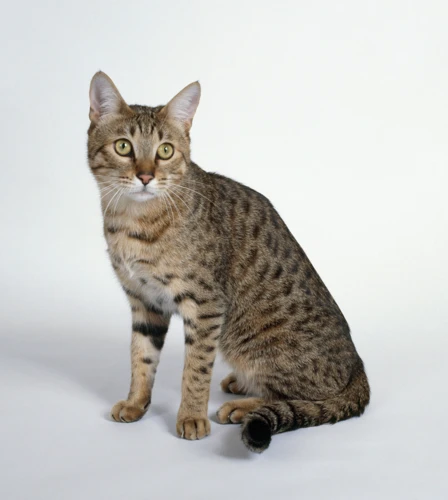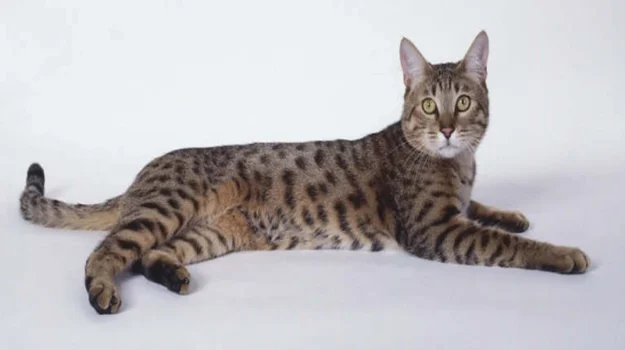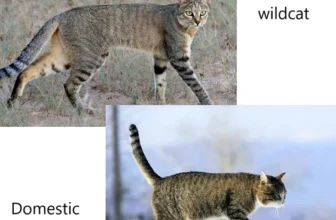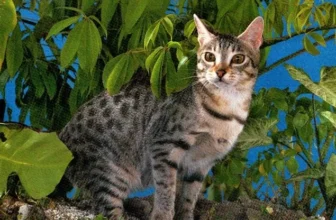The California Spangled cat, once a promising new breed, has unfortunately experienced a significant decline in popularity over the years. This captivating feline, known for its wild appearance and enigmatic personality, was once thought to be a potential contender against the more traditional breeds like the Siamese or Persian. However, behind the scenes, there were various business decisions and practices that contributed to the decline of this fascinating breed. In this article, we’ll take a closer look at the reasons why the California Spangled cat failed to capture the hearts of cat lovers worldwide, from breeding practices to marketing missteps and the economic realities that ultimately sounded its demise.
Breeding Practices

Despite their unique and captivating appearance, California Spangled Cats experienced a rapid decline in popularity from the 1980s onwards. The reasons for this decline are multifaceted, with breeding practices being a major contributing factor. Let’s take a closer look at some of the issues that arose with the breeding of these cats.
For more information about the rise and fall of California Spangled Cats, check out this history of the breed.
Human Preferences Over Genetics
One of the key reasons behind the decline of California Spangled Cats was the preference for appearance over genetic health. Breeders were more focused on producing cats with a specific look, rather than considering the potential health issues that could arise from selective breeding practices. This often resulted in cats with genetic defects or health issues that impeded the breed’s longevity.
Here is a table highlighting some of the genetic concerns that affected the California Spangled Cat breed:
| Genetic Concern | Description |
|---|---|
| Inbreeding | Breeders often used closely related cats to produce the desired look, which led to inbreeding and a restricted gene pool. This amplified genetic defects and health issues in the breed. |
| Heart Disease | California Spangled Cats were prone to developing hypertrophic cardiomyopathy, a condition where the walls of the heart become thickened and disrupt normal blood flow. This was likely a result of selective breeding for appearance over genetic health. |
| Dwarfism | Breeders attempted to produce smaller California Spangled Cats, which resulted in dwarfism. While this may have been desirable for appearance, it was a significant health concern for the breed. |
As breeders prioritized aesthetics over genetic health, it ultimately contributed to the decline of the California Spangled Cat breed. If breeders had focused on creating a genetically healthy breed, it’s possible the breed could have endured and thrived.
While the California Spangled Cat enjoyed a brief burst of popularity in the 1980s, its breeding practices ultimately proved unsustainable and detrimental to the breed’s long-term survival. In contrast to the headstrong pursuit of appearance over genetics during California Spangled Cat’s era, modern cat breeding has shifted towards a greater emphasis on health and genetic diversity. For more about modern breeding practices, see our article on the evolution of cat breeding. Despite the breed’s decline, the California Spangled Cat’s legacy can still be seen in modern breeding practices, such as promoting genetic diversity to prevent inbreeding and genetic defects. We will explore this topic in more depth in our article on the legacy of California Spangled Cats on modern breeding.
Restricted Gene Pool
An inherent problem with the California Spangled Cat was that the breed was created with a very restricted gene pool. Breeders used only a few specific breeds to create the California Spangled, including the Siamese, American Shorthair, and the British Shorthair. This limited pool led to a lack of genetic diversity, increasing the risk of genetic diseases and health issues in the cats (source: California Spangled Cats Popularity in the 1980s).
The breed’s founder, Paul Casey, limited the number of cats that could be used for breeding. Casey believed that this would preserve the breed’s unique characteristics, but it also led to a decline in the breed’s overall health. Inbreeding and a limited gene pool can lead to undesirable traits and genetic defects that can affect the breed for generations.
Despite efforts to address these issues by crossing California Spangled Cats with other breeds, it was too late. The damage had already been done, and the breed never fully recovered. The restricted gene pool had played a significant role in the decline of the breed, as health issues and genetic defects made it difficult for breeders to produce healthy kittens. Ultimately, this led to a loss of interest from cat owners and breeders alike.
Health Issues
One of the major contributing factors to the decline of California Spangled cats was the health issues associated with the breed. Despite being touted as a robust and healthy breed, California Spangled cats were susceptible to various health problems that were not immediately apparent to breeders. This lack of knowledge and understanding of genetics resulted in the breeding of cats with genetic abnormalities, leading to a host of health problems.
One such health issue was a genetic heart defect that affected many California Spangled cats. The lack of genetic diversity in the breed combined with the breeders’ emphasis on physical characteristics over health led to an increase in the prevalence of this heart defect. This defect caused heart murmurs, arrhythmias and other serious complications, making it difficult for the cats to live long, healthy lives.
Another health issue that contributed to the breed’s decline was its susceptibility to respiratory infections. California Spangled cats were often bred in large numbers in confined spaces, which created an ideal environment for the spread of respiratory infections. The breed was also susceptible to various other viral and bacterial infections, which resulted in a high mortality rate among kittens.
The following table highlights some of the common health issues associated with California Spangled cats:
| Health Issue | Description |
|---|---|
| Genetic heart defect | Causes heart murmurs, arrhythmias and other serious complications |
| Respiratory infections | Caused by breeding in large numbers in confined spaces, resulting in a high mortality rate among kittens |
| Other viral and bacterial infections | Susceptibility to various viral and bacterial infections, resulting in a high mortality rate among kittens |
The health issues associated with California Spangled cats were a significant contributing factor to the breed’s decline. The lack of genetic diversity, combined with breeders’ emphasis on physical characteristics over health, led to the breeding of cats with genetic abnormalities that resulted in a host of health problems. Ultimately, these health issues made it difficult for California Spangled cats to live long, healthy lives, and contributed to the decline of the breed’s popularity.
Marketing Missteps

As promising as the California Spangled Cat’s unique spotty coat and wild, athletic nature seemed, not all of the factors leading to their decline can be traced back to genetics. There were some well-meaning marketing decisions that, although made with the best of intentions, did not always yield strong results. Let’s take a closer look at some of these questionable promotional moves and how they contributed to the ultimate demise of this once-popular breed.
Failure to Capture Popular Imagination
Despite its unique and striking appearance, California Spangled Cats failed to capture the popular imagination of cat lovers. The breed was introduced in the 1980s, at a time when interest in exotic cat breeds was on the rise. However, it was unable to generate the same level of interest as breeds like the Bengal and the Savannah.
One possible reason for this lack of popularity is that the California Spangled Cat was marketed as a luxury item, rather than a companion animal. The breed was initially positioned as a status symbol for the rich and famous, with ads featuring models posing with the cats as accessories. This marketing strategy may have turned off potential cat owners who viewed the breed as a flashy and impractical choice.
Another factor that may have contributed to the breed’s failure to capture the popular imagination is its limited availability. California Spangled Cats were only sold through select breeders, and their high price point made them a niche product. As a result, many cat lovers may not have been aware of the breed or had access to it.
The breed’s lack of recognition was further compounded by the fact that it was not recognized by major cat organizations like the Cat Fanciers’ Association. This lack of validation made it less appealing to serious cat owners and breeders, who often look to these organizations for guidance on which breeds to pursue.
In the end, the failure to capture the popular imagination was a key contributing factor to the decline of the California Spangled Cat breed. Despite its striking appearance and potential as a unique companion animal, the breed was unable to gain the widespread recognition and appeal necessary to sustain its breeding and popularity over time.
- California Spangled Cats failed to capture the popular imagination of cat lovers
- The breed was marketed as a luxury item, rather than a companion animal
- Marketing strategy may have turned off potential cat owners who viewed the breed as a flashy and impractical choice
- California Spangled Cats were only sold through select breeders and their high price point made them a niche product
- The breed’s lack of recognition from major cat organizations made it less appealing to serious cat owners and breeders
- The failure to capture the popular imagination was a key contributing factor to the decline of the California Spangled Cat breed
Pricing Strategy
One major contributor to the decline of California Spangled Cats was their pricing strategy. Breeders had initially set the price of these cats high, as a way to create an air of exclusivity and luxury around them. However, this strategy backfired as demand for the breed never quite took off.
Poor Market Research: The breeders failed to conduct proper market research before setting the high prices. They didn’t take into account the tastes and preferences of potential buyers, nor did they evaluate the demand for such a new breed. As a result, they set prices that were unaffordable for most people.
Inability to Compete with Established Breeds: California Spangled Cats also faced competition from other established and popular breeds, such as Persians, Siamese, and Maine Coons. Many of these breeds had been around for years and had a loyal following. The high price of California Spangled Cats made it difficult for them to compete in an already saturated market.
The Perceived Lack of Value: Due to the high prices, many potential buyers felt that the California Spangled Cats did not offer enough value for the money. Some argued that they were just another breed of cat, with no special features or qualities that would justify their pricing.
The Disconnect Between Price and Reputation: Despite having a positive reputation, with many people praising their beauty and personality, California Spangled Cats failed to deliver on their high pricing. Many breeders did not invest in training and socialization of the cats, which resulted in ill-behaved cats that did not meet the expectations of their owners.
The pricing strategy used by the California Spangled Cats breeders was a major factor in their decline. Instead of creating an image of luxury and exclusivity, they priced their cats out of reach for most people. They failed to provide enough value to justify the high pricing, resulting in a less-than-stellar reputation among potential buyers.
Limited Distribution
One of the major errors made by those involved in the California Spangled Cat breed was the lack of thought put into distribution. Rather than working to establish a broad network of breeders and enthusiasts, the distribution was limited to a select few individuals and regions. This lack of forethought limited the reach of the breed and also gave the impression that the breed was exclusive, which was not appealing to the average consumer.
The lack of accessible breeders meant that the majority of individuals interested in obtaining a California Spangled Cat had to rely on the few breeders that existed, despite their location. Some potential owners were willing to travel long distances to purchase a California Spangled Cat but the vast majority weren’t, which resulted in low demand.
Another issue that arose from limited distribution was the inability to establish a fanbase. As new breeds emerge, breeders, enthusiasts, and owners establish communities, fan pages, and blogs where they can share their experiences and knowledge with others. Because of the limited distribution, the breed failed to gain the momentum and fan base that it would have needed to become a success.
The table below demonstrates the distribution issues faced by California Spangled Cats:
| Issue | Impact |
| Exclusive distribution | Appealed only to a limited audience and resulted in low demand |
| Limited accessible breeders | Denied potential owners easy access to the breed |
| Limited breed network | Failed to establish fanbase or community and gain the momentum to succeed |
In an industry where popularity is critical to success, limited distribution proved detrimental to the overall success and survival of the California Spangled Cat breed. Reaching beyond a small clique of breeders and enthusiasts and seeking to broaden the scope of the breed through a vast network of breeders and advocates may have resulted in a different outcome.
Economic Realities
As much as breeding practices and marketing strategy played a significant role in the decline of California Spangled Cats, it was ultimately economic realities that delivered the final blow. The once-promising breed was unable to compete in a market saturated with established feline breeds, while also dealing with rising costs of care and maintenance. The future of the California Spangled Cat looked bleak, and in this section, we will explore some of the overwhelming economic factors that contributed to their downfall.
Competition from Established Breeds
One of the main reasons for the decline of California Spangled Cats was the fierce competition from established breeds. While the California Spangled Cat had unique and desirable traits, it was up against well-known and beloved breeds such as the Siamese, Persian, and Maine Coon.
To better understand the competition that the California Spangled Cat faced, let’s take a closer look at some of the most popular established breeds:
| Breed | Characteristics | Popularity |
|---|---|---|
| Siamese | Elongated body, triangular head, striking blue eyes | One of the oldest and most popular cat breeds, widely recognized and beloved |
| Persian | Fluffy coat, flat face, calm temperament | Highly popular and well-known breed, preferred by many due to its luxurious appearance and gentle personality |
| Maine Coon | Large size, shaggy fur, gentle and sociable nature | One of the most popular breeds in the United States, with a loyal fanbase that appreciates its friendly and outgoing personality |
As you can see, each of these breeds has its own unique traits and characteristics that make them stand out from the rest. This made it difficult for the California Spangled Cat to make a name for itself in the competitive world of cat breeds.
Many of these established breeds had already secured their place in the hearts of cat lovers worldwide, which made it even harder for the California Spangled Cat to break into this market. It takes time and effort to build up a reputation, and unfortunately, the California Spangled Cat didn’t have the time or the backing to establish itself as a viable competitor against these well-known breeds.
The California Spangled Cat was up against tough competition from established breeds that had already won the hearts of cat lovers around the world. While the California Spangled Cat had unique traits that set it apart from the rest, it was ultimately unable to compete with these beloved and well-established breeds.
Changing Consumer Preferences
As the years went on, consumer preferences began to shift in regards to what they were looking for in a pet. The California Spangled Cat, with its exotic and wild appearance, no longer held as much allure as it once did. Instead, people began to gravitate towards cats that were smaller, more subdued, and easier to take care of.
One reason for this shift in consumer preferences was the rise of apartment living. As more and more people moved into urban areas, there was a greater need for cats that could comfortably live in small spaces. The California Spangled Cat’s larger size and more active personality made them less desirable for apartment dwellers who wanted a cat that was more low-maintenance.
Another factor that contributed to the changing consumer preferences was the rise of social media. Cute and photogenic cats like the Scottish Fold and the Bengal gained popularity on platforms like Instagram, while the California Spangled Cat was largely forgotten.
Finally, the changing economic landscape also had an impact on consumer preferences. As people struggled with financial hardships, they become less willing to invest in expensive and exotic pets like the California Spangled Cat. Instead, they opted for more affordable and common breeds like the Siamese or Persian.
The changing consumer preferences played a significant role in the decline of the California Spangled Cat. While they were once an intriguing and exotic breed, their larger size and more active personality fell out of favor with people who were looking for more low-maintenance pets. As a result, breeders struggled to find a market for them, and the breed gradually faded into obscurity.
Rising Costs of Care and Maintenance
As with any pet, taking care of a California Spangled cat requires a significant investment of time and money. However, the rising costs of care and maintenance have contributed to the decline of this once-popular breed. Here are some factors that have made it increasingly difficult for cat owners to keep up with the costs:
- Veterinary treatment: California Spangled cats are known to be prone to certain health problems such as hip dysplasia and heart disease. Treating these conditions requires regular visits to the vet, which can be expensive.
- Specialized grooming: The California Spangled cat has a short, smooth coat that is easy to maintain. However, the breed is known to shed heavily, and regular grooming is necessary to avoid hairballs and matting. This grooming can be done at home, but many owners prefer to take their cats to a professional groomer, which can be costly.
- Diet: Proper nutrition is important for the health and longevity of any cat, but the California Spangled cat has a unique dietary requirement. They require a high-quality cat food that is high in protein and low in fat to maintain their lean physique. This can be more expensive than generic cat food.
- Time commitment: California Spangled cats are intelligent and active, which means they require a lot of mental and physical stimulation. This can be time-consuming for owners who work long hours or have other time commitments.
- Accessories: The California Spangled cat is a unique breed, and as such, owners may want to purchase specialized accessories such as beds and scratching posts. These specialized items can be more expensive than generic ones.
All of these factors have contributed to the rising costs of care and maintenance for California Spangled cat owners. While many pet owners are willing to invest time and money into their furry companions, the high costs associated with caring for a California Spangled cat may have played a role in the breed’s decline in popularity over time.
Conclusion
After analyzing the various factors that contributed to the decline of California Spangled Cats, it becomes clear that the breed faced a perfect storm of breeding practices, marketing missteps, and economic realities. The decision to prioritize human preferences over genetics led to a restricted gene pool, which in turn led to a slew of health issues that plagued the breed.
Furthermore, marketing missteps such as a failure to capture popular imagination, poor pricing strategies, and limited distribution channels only served to compound the breed’s problems. The lack of widespread appeal and limited accessibility made it difficult for California Spangled Cats to gain a foothold in the hearts and homes of cat lovers everywhere.
In the face of fierce competition from established breeds with stronger recognition and more loyal followings, California Spangled Cats simply couldn’t compete despite their unique and striking appearance. Changing consumer preferences towards more traditional pedigrees further hastened the breed’s decline.
Finally, rising costs of care and maintenance proved to be the final nail in the coffin for many breeders, pushing them out of the market and leaving the California Spangled Cat with little hope for revival.
In conclusion, while the California Spangled Cat was a beautifully unique breed with impressive physical and intellectual characteristics, the various factors at play proved to be too much to overcome. It remains a tragic example of how even the most promising of breeds can falter when faced with an array of complex problems.
Frequently Asked Questions
What are California Spangled Cats?
California Spangled Cats are a rare breed of domestic cat that were first created in the 1980s by Paul Casey. The breed was known for their leopard-like spots and athletic abilities.
Why did California Spangled Cats decline in popularity?
California Spangled Cats declined in popularity due to a variety of factors including breeding practices, marketing missteps, and economic realities.
What were the breeding practices of California Spangled Cats?
The breeding practices for California Spangled Cats involved human preferences over genetics, a restricted gene pool, and health issues, which led to a decrease in the overall health and quality of the breed.
What were the marketing missteps for California Spangled Cats?
The marketing missteps for California Spangled Cats included a failure to capture popular imagination, a pricing strategy that was too high for most consumers, and limited distribution that made it difficult for people to adopt the breed.
How did competition from established breeds affect the decline of California Spangled Cats?
The competition from established breeds made it difficult for California Spangled Cats to gain a foothold in the market, even with their unique qualities and characteristics.
What were the changing consumer preferences that contributed to the decline of California Spangled Cats?
The changing consumer preferences for smaller and more docile cats made it difficult for California Spangled Cats to stand out in the market, even with their unique spots and athleticism.
What were the rising costs of care and maintenance that contributed to the decline of California Spangled Cats?
The rising costs of care and maintenance for California Spangled Cats made it difficult for people to justify adopting them, as they required a lot of attention and resources to keep healthy.
Are California Spangled Cats still available for adoption?
Although California Spangled Cats are rare, they can still be found for adoption through specialized breeders and rescue organizations.
What makes California Spangled Cats unique?
California Spangled Cats are unique due to their leopard-like spots and athleticism, which set them apart from other breeds of domestic cats.
Can California Spangled Cats make good pets?
Yes, California Spangled Cats can make great pets for people who are willing to devote the time and resources necessary to care for them properly.







